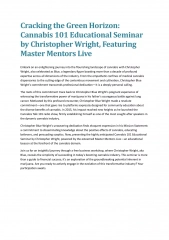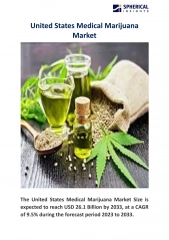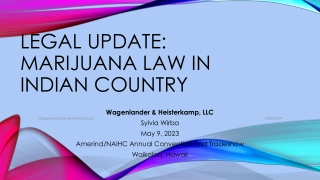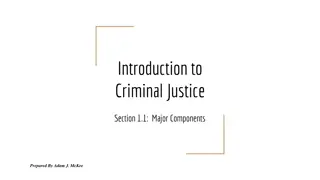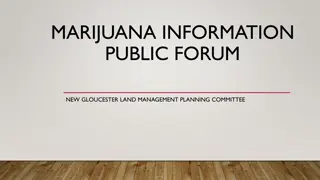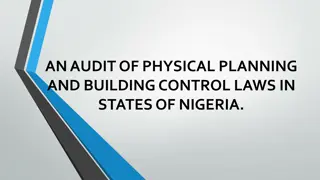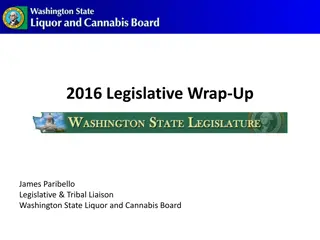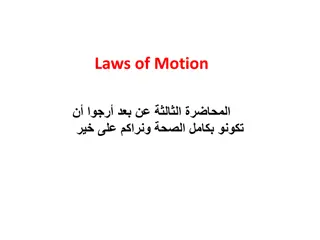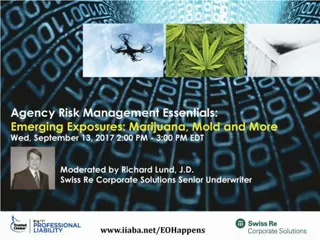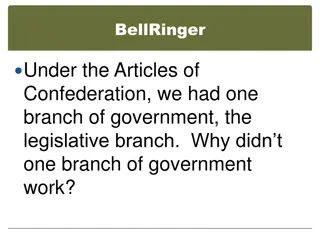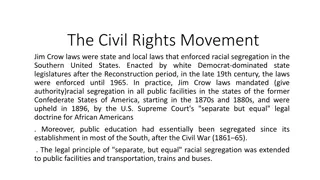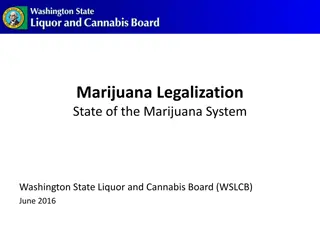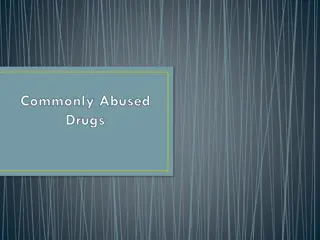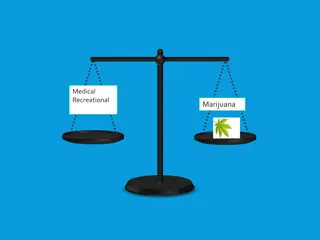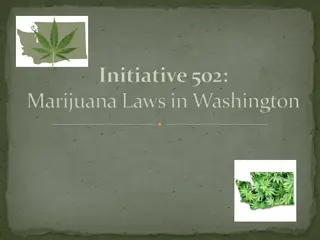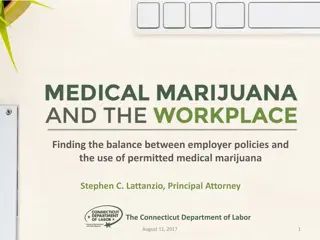Overview of Marijuana Laws in the United States
The Controlled Substances Act of 1970 categorizes drugs into 5 schedules based on abuse potential and medical utility. Marijuana remains a Schedule I drug due to high abuse potential and lack of accepted medical use. Federal law defines marijuana as Cannabis sativa L. along with its derivatives. Various federal regulations govern industrial hemp, prescription medications, over-the-counter products, and dietary supplements.
Download Presentation

Please find below an Image/Link to download the presentation.
The content on the website is provided AS IS for your information and personal use only. It may not be sold, licensed, or shared on other websites without obtaining consent from the author.If you encounter any issues during the download, it is possible that the publisher has removed the file from their server.
You are allowed to download the files provided on this website for personal or commercial use, subject to the condition that they are used lawfully. All files are the property of their respective owners.
The content on the website is provided AS IS for your information and personal use only. It may not be sold, licensed, or shared on other websites without obtaining consent from the author.
E N D
Presentation Transcript
Marijuana in Maine Deanna L. White, AAG August 2, 2018
Short History of Federal Law Controlled Substances Act (1970) Regulates manufacture, possession, use, and distribution of certain drugs with abuse potential These drugs are assigned to one of 5 schedules Schedule depends on potential for abuse, known scientific evidence of effects and medical utility Unlawful (criminal) to manufacture distribute or possess with intent to distribute, controlled substances (except in accordance with the Act) 21 USC 841(a) Enforced by USDOJ DEA
Schedules Schedule I: high potential for abuse; drug has no currently accepted medical use in treatment in the US; and lack of accepted safety for use of that drug Marijuana and THC remain on Schedule I, thus cannot be prescribed Schedule II drugs have currently accepted medical use in the US, high potential for abuse, and abuse my lead to severe dependence
Schedules Continued Schedules III-V all have currently accepted medical use in US and decreasing abuse potential compared to the next high schedule Marijuana has not been rescheduled yet, including after petition and assessment in 2016 Several versions of synthetic THC have been approved and are on Schedules II and III
Federal Definition of Marijuana Marihuana" means all parts of the plant Cannabis sativa L., whether growing or not; the seeds thereof; the resin extracted from any part of such plant; and every compound, manufacture, salt, derivative, mixture, or preparation of such plant, its seeds or resin. Such term does not include the mature stalks of such plant, fiber produced from such stalks, oil or cake made from the seeds of such plant, any other compound, manufacture, salt, derivative, mixture, or preparation of such mature stalks (except the resin extracted therefrom), fiber, oil, or cake, or the sterilized seed of such plant which is incapable of germination. 21 USC Sub- 802(16).
Other Federal Laws and Regs USDA Industrial Hemp Farm Bill USDHHS FDA Prescription Meds FDA Over-the-Counter Monographs FDA Dietary Supplements
Rohrabacher-Blumenthal Amendment Has been included in federal budget and appropriations bills for several years now Last updated March 23, 2018 for 6 months Prevents DOJ from expending federal dollars to interfere with state s (including Maine) medical marijuana programs Covers medical marijuana patients (feds cannot prosecute for possession) US v. McIntosh, 833F.3d 1163(9thCir. 2016) Covers states and program administrators re medical marijuana No such protections for state Adult Use or Personal Use marijuana laws
Maine Law Maine Criminal Law 17-A MRS Chapter 45 Definition of marijuana is leaves, stems, flowers and seeds but not resin Hashish or resin extracts are subject to higher penalties Criminalizes trafficking, furnishing, cultivation of marijuana, and unlawful possession Citizen's Initiative 1998: Medical Marijuana Medical use, designated caregivers, affirmative defense for cultivating and possession
Maine Medical Use of Marijuana Act (MMUMA) In 2009, the Act became law pursuant to an Initiated Bill approved by the Maine voters. I.B. 2009, ch. 1. In general terms, the Act and rules authorize certain persons to engage in certain conduct involving marijuana, notwithstanding the existence of other Maine laws, including the Maine Criminal Code.
Adult Use and Personal Use Initially enacted as a citizen s IB 2015, c. 5; some parts were effective January 30, 2017 and some parts were put off and then repealed in 2018 PL 2017, Ch. 409 (eff. May 2, 2018) repealed 7 MRS c. 417 and enacted (as an emergency legislation) 28- B MRS Ch. 1) PL 2017, Ch. 409 also moved the Maine Medical Marijuana Program out of the Department of Health and Human Services and into Department of Administrative and Financial Services (DAFS) 22 MRS 2422 (1-C), 2422(2-A).
Everything which is not forbidden is allowed or Vice Versa State medical and adult use marijuana laws authorize, allow or permit activities that would otherwise be criminal or civil violations under both federal and state laws The activities these laws authorize are heavily regulated and people/entities that are not acting in accordance with these laws are thereby often acting unlawfully See e.g. MMUMA 22 MRS 2426; Adult Use, 28- B MRS 801-804; 1504.
Marijuanas plant characteristics Family: Cannabaceae Genus: Cannabis. An annual, dioecious, flowering herb. Normally male and female flowers occur on separate plants. Cannabis is wind pollinated and produces seeds inside tiny fruits (achenes).
Species Sativa Cannabis Sativa Linnaeus (L.) Linnaeus concluded one species for genus Cannabis Sativa with different subspecies of sativa, indica, and ruderalis Most botanists and the US government go by this classification Some disagree and argue indica and ruderalis are different species from sativa
Many Uses and Cultivars Seeds (achenes) for food and hemp seed oil Stalks for fiber Resin for drugs and drug oils (THC, CBD, Cannabis oil and CBD oil) Plants best for industrial hemp are low total resin plants, grown outdoors and machine harvested; bamboo-like Drug plants, whether for THC or CBD are high resin, hand tended, and hand harvested plants; large shrubs
Cannabinoids Cannabis plants produce chemicals called cannabinoids which are secreted by trichomes that occur most abundantly on the floral calyxes and bracts of female plants. If cannabinoids are the goal of growing, a grower wants un-pollinated female plants, and no male plants Usually stared by clones (cuttings), whereas industrial hemp is started with registered seed
Endocannabinoids In much of animal kingdom Endogenous cannabinoids: endocannabinoids Part of physiology; body creates them Existed before Cannabis Cannabis and Cannabinoids evolved to be bio- mimics of endocannabinoids Pre-existing docking stations in the brain for these chemicals
A Tale of Two Drugs There are many different cannabinoids but the two most studied so far are tetrahydrocannabinol delta-9 (THC) and cannabidiol (CBD) THC docks at the brains cannabinoid receptors and main psychoactive effect is inebriation or high CBD behaves differently in the brain, has different psychoactive effects-sedation or anxiolytic (though effects less clear than THC) without inebriation Growers have become skilled at growing plants with very high resin content, and differing THC to CBD ratios Purveyors have become skilled at concentrating and isolating these chemicals, crystal THC-a and crystal CBD
Terpenes and the Entourage Effect Terpenes are major components of resin (besides cannabinoids) Terpenes can affect the brain and body themselves, but also seem to interact with THC and CBD Entourage effect: interactions of THC and CBD in different ratios, and terpenes
Resin, Isolates, and Extractions Cannabis plants are being bred with ever higher resin percentages Charlotte s Web 20% CBD,.o5% THC Sour Tsunami 11% CBD, 10% THC Gorilla Glue .05% CBD, 25%THC Cf. Finola (industrial hemp) 2%CBD, .24% THC Extraction technologies concentrate resins, purify and isolate THC and CBD Potent! Smaller amounts of bud/concentrate have ever more doses of these drugs
Whats in a Dose? Calculated doses based on Colorado s Medical Equivalency in Portion and Dosage. For one ounce of flower/bud with 17.1% THC content you can get more than 425 doses of 10 mg each. This would be 1,063 doses per 2.5 ounces, and 2,126 doses per 5 ounces - which a QP can purchase in a month (under PL 2017, Ch. 452 [LD 1539]it will be 8 pounds in any form of harvested marijuana). That is 6,800 doses per pound so potentially 54,400 doses from 8 pounds of harvested marijuana; or 1,360,000 doses per 200 pounds that Tier 2 manufacturing licensees could possess at one time.
Amounts For a long time the usual amount of medical marijuana for a year was 1 pound of bud/leaf More recent averages for medical marijuana users is around 1-2 ounces per month Colorado considers 10mg THC a dose Cf. starting dose of Dronabinol (synthetic THC) would be about 5 mgs to help with nausea Amounts allowed under various laws for cultivation and possession have been overly generous for many patients
CBD & Industrial Hemp CBD oil meets the definite of marijuana under the Controlled Substances Act ( CSA ) because it is derived from the resin of the plant. Marihuana" means all parts of the plant Cannabis sativa L., whether growing or not; the seeds thereof; the resin extracted from any part of such plant Such term does not include the mature stalks of such plant, fiber produced from such stalks, oil or cake made from the seeds of such plant, any other compound, manufacture, salt, derivative, mixture, or preparation of such mature stalks (except the resin extracted therefrom), fiber, oil, or cake, or the sterilized seed of such plant which is incapable of germination. 21 USC 802(16).
Low THC Industrial hemp is the subject of a federal program under the Agriculture Act ( Farm Bill ) of 2014 at Section 7606(b)(2). Section 7606 protects certain entities who grow and use industrial hemp (with <.3% THC by dry weight). for research projects. Industrial hemp may only be grown by an institution of higher education or a state department of agriculture for purposes of research conducted under an agricultural pilot program or other agricultural or academic research, and if the growing or cultivating of industrial hemp is allowed under the laws of the state where the cultivation or research occurs. Maine has a program for industrial hemp growers, but it does not meet the requirements of the federal program in the Farm Bill and so does not provide much protection against the federal CSA. 7 MRS 2231.
CBD is not Industrial Hemp CBD Oil can be extracted from industrial hemp strains that have less than .3% THC because these hemp varieties usually have some CBD but it is also usually low, at 1-3% or so. To add to the confusion there are high resin, high CBD strains that have <.3% THC). More importantly industrial hemp covers only that which is used for industrial purposes (fiber and seed). Products from industrial hemp may be sold for purposes of marketing research by institutes of higher education or state departments of agriculture, but not for purposes of general commercial activity. US Secretary of Agriculture, July 25, 2016, Federal Register, Vol. 81, No. 156 p.53395-53396.
CBD is a drug The US DEA issued a press release in 2015 stating CBD oil is a marijuana derivative, and that industrial hemp does not cover marijuana derivatives that are marketed commercially as drugs. The US FDA has sent warning letters (including Fall 2017) to several large CBD oil manufacturers telling them to stop marketing CBD oil as a treatment for diseases (drug) and also that is does not qualify as a dietary supplement. Nonetheless, many entities claim that their CBD is from industrial hemp and therefore it is legal Manufacture and use of CBD oil can be done in Maine is if it is done pursuant to the MMUMA. CBD Oil meets the definition of prepared marijuana (22 MRS 2422(14)). Therefore manufacture, possession, sale, and use by authorized persons is allowed under 22 MRS Chapter 558-C, and also Adult/Personal Use laws.
CBD is a now a prescription drug approved by the FDA 1980 studies in Israel, Dr. Raphael Mechoulam Patients with epilepsy suffered fewer seizures June 2018, Epidiolex approved by US FDA for Dravet Syndrome and Lennox-Gastaut Syndrome Prescription drug, not OTC Botanical drug not chemical copycat Because FDA approved it as a prescription drug it meets the requirement of having a currently acceptable medical use in the US Before it can be prescribed and sold in US DEA will have to reschedule at least part of marijuana (CBD)
Back to MMUMA 22 MRS Chapter 558-C 10-144 Code of Maine Rules (CMR) Chapter 122, Maine Medical Use of Marijuana Program Rule, February 1, 2018 Lawsuit challenging the enforcement provisions of these rules, Olsen, et al v. Hamilton, USDC Me, 1:18-cv-00022-NT, recently dismissed (July 10,2018).
More on MMUMA Authorized conduct includes cultivating and selling for caregivers and dispensaries; cultivation for qualified patients; designations required 22 MRS 2423-A to 2423-D Amended 2011 Privacy; patients do not have to register anymore but still must designate a caregiver or dispensary Amended 2018 Manufacturing as a separate business and extraction of concentrate, including with inherently hazardous substances (PL 2017, Ch. 447 [LD 283] eff. July 9, 2018
MMUMA Entities MMUMA qualifying patient is a person who has a valid written certification regarding medical use of marijuana in accordance with section 2423-B. 22 MRS 2422(9). Qualifying patients may designate a person as their primary caregiver or registered dispensary to cultivate for them or cultivate marijuana for their own medical use pursuant to 22 MRS 2423-A(1), 2423-A(3), or 2428(1-A) Primary caregiver is a person who provides care for a qualifying patient in accordance with 22 MRS 2423-A(2).. Registered Dispensaries 22 MRS 2428 Manufacturing facilities 22 MRS 2423-F Concentrate extractors using Inherently Hazardous Substances 22 MRS 2423-F(3)
MMUMA Cultivation A qualifying patient may cultivate up to six mature marijuana plants. 22 M.R.S.A. 2423-A(1)(B). In addition, the patient who is cultivating his or her own marijuana may possess up to 8 pounds of incidental marijuana and 2.5 ounces prepared marijuana Registered caregivers may grow up to 30 mature plants (6 plants x 5 patients) for patients who designate them. 22 MRS 2423-A. Registered dispensaries may cultivate up to 6 mature plants for patients who designate them
Coming Attractions MMUMA From PL 2017, Ch. 452 [LD 1539] (eff. 90 days after current session ends) No more designations No more debilitating medical conditions; palliative or therapeutic benefit for their medical diagnosis Qualified patients may possess up to 8 pounds of harvested marijuana (any form including concentrates) Any amount of marijuana from 30 plants of primary caregivers Registered dispensaries no longer need to be non- profits and can grow as much as want so long as selling to qualified patients
Adult Use, Title 28-B MRS Adult Use sets up a system of highly regulated marijuana businesses for use by adults over 21 Marijuana means the leaves, stems, flowers and seed of a marijuana plant, whether growing or not and includes marijuana concentrate but not industrial hemp as defined in 7 MRS 2231(1) or a marijuana product 28-B MRS 102(27) Marijuana concentrate means the resin extracted from any part of a marijuana plant and every compound, manufacture, salt, derivative, mixture or preparation from such resin, including, but not limited to, hashish 28-B MRS 102(28) New MMUMA definitions are similar
Tracking System DAFS to implement and administer a system for the tracking of adult use marijuana and adult use marijuana products from immature marijuana plant to the point of retail sale, disposal or destruction. 28-B MRS 105
Municipalities and Adult Use Notification to municipality when DAFS approves, renews, denies, suspends or revokes a license. 28-B MRS 215 Allows for local regulation/authorization of adult use businesses. 28-B MRS 401-406
Adult Use Businesses 28-A MRS 201 Cultivation facility (Tier 1 Tier 4) Tier 4 is largest at about acre of plant canopy Testing facility Products manufacturing facility Marijuana store Adult use law also allows for shared use of cultivation facilities by combo medical marijuana and adult use businesses. 28-B MRS 501
Personal Use Personal Adult Use of Marijuana and Marijuana Products 28-B MRS 1501-1504 Use, possess or transport at any one time 2.5 ounces (70 grams), with no more than .5 ounces of that as concentrate 70 grams makes 86 (.8 gram) joints; can be over 1000/10mg doses Transfer or furnish, without remuneration that same amount
Personal Cultivation Any person over 21 can possess, cultivate or transport at any one time up to 3 mature, 12 immature, and an unlimited number of seedling marijuana plants Transfer up to 6 immature marijuana plants without remuneration Remuneration includes a donation or any other monetary payment received directly or indirectly by a person in exchange for goods or services
Personal Consumption May only be consumed in a private residence, including curtilage, or On private property not generally accessible by the public, and the person is explicitly permitted to consume marijuana or marijuana products on the property by the owner of the property. May not be consumed while operating a vehicle, in private residence during time a day care or babysitting service is operated, by smoking in a designated workplace smoking area, by smoking in a public place, or in a public area where smoking is prohibited under 22 MRS Ch. 262
Local Control of Personal Grow Municipalities and Maine Land Use Planning Commission may regulate the home cultivation of marijuana. 28-B MRS 1502(3) &(4) May limit the total number of mature plants that may be cultivated on any one parcel or tract of land so long as that limitation allows for the cultivation of 3 mature plants, 12 immature marijuana plants and an unlimited number of seedlings by each person 21 year of age or older who is domiciled on a parcel or tract of land
Employment: MMUMA Medical Marijuana- status is protected; use during work not protected; use outside of work might be reasonable accommodation in certain cases (when medical marijuana is the most effective medication and any alternative would be less effective) Barbuto v. Advantage Sales and Marketing, LLC 477 Mass. 456 (2017) Some employers may accommodate medical marijuana use Employee cannot work under the influence of marijuana where that would constitute negligence or professional malpractice or would otherwise violate any professional standard 22 MRS 2426(1)(A) If employer is a federal or state entity/contractor, all bets off due to Drug Free Workplace laws and contract provisions
Employment: Adult Use Adult Use, 28-B MRS 112; 1501(2), Employer not required to permit or accommodate the use, consumption, possession, trade, display, transportation, sale or cultivation of marijuana or marijuana product in the work place. May discipline employees who are under the influence at work or within scope and course of employment If federal or state contractor/entity, all bets off due to Drug Free Workplace law and contract provisions Workplaces that are not federal or state contractors could possibly allow adult use by employees if personal consumption law met
Landlords Maine law leaves it up to LL (at LL s risk) whether tenants smoke, cultivate, manufacture, use inherently dangerous substances to extract, sell, or operate a business including cannabis on LL s property Remember, Rohrabacher-Blumenthal covers only medical marijuana use, not Adult or Personal Use. Also, if LL accepts public monies, or are a publically owned property, see HUD and Maine (State) Housing directives which prohibit use of marijuana LLs do not have to accommodate smoking of medical marijuana if they prohibit all smoking on the premises and post notice of that
Health care providers Still cannot prescribe, distribute, or administer medical marijuana, Gonzales v. Raich, 545 US 1 (2005) If CBD (Epidiolex) is rescheduled that it can be prescribed and dispensed by a DEA registered provider
Smoking and Vaping No public smoking or vaping of medical marijuana in public places protected by the smoking laws 22 MRS Ch. 262 No smoking of medical marijuana in any public place (indoor or outdoor) 22 2426(1)(C) Personal use (including smoking) can only be done in a private residence including curtilage or on private property not generally accessible by the public and with explicit permission by the owner of the property 28-B MRS 1501(2)(A)
Health Insurance Government medical assistance programs and private insurers do not have to reimburse for medical marijuana 22 MRS 2426 Employers cannot be ordered by the Worker's Comp Board to reimburse for medical marijuana Bourgoin v. Twin Rivers Paper Co., LLC, et.al., (2018 ME 77)
Hospitals, Nursing Homes Regardless of what state laws say, if an entity accepts Medicare, MaineCare, or other federal monies allowing even medical marijuana on the premises may cause problems for the owner Medicaid money cannot be used to pay for administration of medical marijuana; it is not medical assistance as defined in federal law 42 USC 1396d(a)
Listening to Cannabis THC isolate: stupefying high, effects on blood pressure, developing brain, heart, psychosis CBD isolate: effects on liver, sedative, epilepsy Neither of these drugs helps everyone; more or stronger is not necessarily better Because THC and CBD are very different so studies being done and knowledge being gained can be confusing: cannabis causes or can treat psychosis; cannabis being used to treat Substance Use Disorder, including Cannabis Use Disorder
Lessons Learned or Not Too much marijuana: California, Oregon, and others have produced a glut of marijuana and are not able to account for the majority of the marijuana produced in their states Oregon US Attorney reported for year 2017, 16 other states seized diverted Oregon marijuana; enough marijuana for 5 ounces to every person; Adult Use 1M pounds in pipeline but 108th pounds sold; 891th pounds leftover Oregon State Police study (January 2017)showed extensive diversion out of state; one authority estimated 3-5 times what is consumed is leaving the state
Justice Scalias Maxim on Marijuana Drugs like marijuana are fungible commodities. marijuana that is grown at home and possessed for personal use is never more than an instant from the interstate market and this is so whether or not the possession is for medical use or lawful use under the laws of a particular state. Gonzales v. Raich, 545 US 1 (2005)(J.Scalia, concurring).
Safety Issues Public Safety; driving under the influence and accidents; still have no good test or standard levels for driving under influence of marijuana Colorado 40% increase in fatal crashes; + alcohol up 17%; +marijuana up 145% (2013- 2016); Denver Post 8.28.2017 Workplace safety, still have no standard tests for under the influence Little is known about how long THC stays in the system


